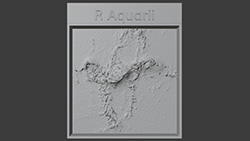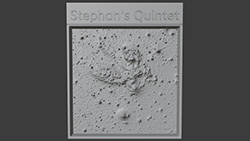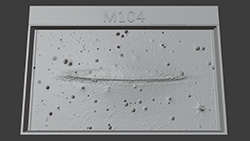1
X-ray, Optical, & Infrared ImagesSonification Credit: NASA/CXC/SAO/K.Arcand, SYSTEM Sounds (M. Russo, A. Santaguida)
Sonification is a process that translates data into sounds and notes that humans can hear. Each layer of sound in these three new NASA sonifications represents particular wavelengths of light detected by Chandra, Webb, Hubble, and Spitzer in various combinations. The sonifications in this release include R Aquarii, a system with a red giant and white dwarf in orbit around each other; Stephan’s Quintet, a collection of galaxies bound together by gravity; and M104, a spiral galaxy similar to the Milky Way but seen edge on from Earth’s vantage point. [Listen to the sonifications here].
2
3D Printable Files: R Aquarii (3D Print Credit: NASA/CXC/A. Jubett, using software by Tactile Universe/N. Bonne & C. Krawczyk & Blender)
3D Printable Files: Stephan's Quintet
(3D Print Credit: NASA/CXC/A. Jubett, using software by Tactile Universe/N. Bonne & C. Krawczyk & Blender)
(3D Print Credit: NASA/CXC/A. Jubett, using software by Tactile Universe/N. Bonne & C. Krawczyk & Blender)
3D Printable Files: M104
(3D Print Credit: NASA/CXC/A. Jubett, using software by Tactile Universe/N. Bonne & C. Krawczyk & Blender)
(3D Print Credit: NASA/CXC/A. Jubett, using software by Tactile Universe/N. Bonne & C. Krawczyk & Blender)
Different telescopes detect different types of light. Much of what they capture is recorded as digital data. Those data can then be translated into visuals, sounds, and tactile relief maps. In today’s release, the data from three different astronomical observations is presented in collections of visualizations, sonifications, and tactile plates.
The first collection features observations of the system R Aquarii. There, a white dwarf star and a red giant star are in orbit around one another. In the composite tactile plate, the two stars are represented by a raised area at the center of the image. The stars sit at the center of a giant, wispy cross that extends to all four edges of the plate. This structure is evidence of outbursts generated by the pair of stars. A wavy line creates a ridge of shapes along the horizontal bar of the cross. These shapes represent an X-ray jet from the white dwarf star. The jet creates shockwaves as it bangs into surrounding material.
The second collection features observations of Stephan’s Quintet, a gathering of four galaxies held together by gravity. The fifth galaxy appears to be part of the group from our perspective, but is in fact much closer to us. The composite tactile plate combines optical, X-ray, and infrared data. In it, the galaxies are clumped together, resembling the wings of a butterfly. The distinct clouds are marbled with bumpy veins, and connected by streaks of material.
The third collection features observations of a large galaxy known as Messier 104. Messier 104 is a spiral galaxy, but from Earth, we observe its edge, not its face. In the composite tactile plate, Messier 104 resembles a cloud with a raised core, encircled by a horizontal ring of spiraling arms. In the background are dozens of dots, which represent distant stars and galaxies.
The first collection features observations of the system R Aquarii. There, a white dwarf star and a red giant star are in orbit around one another. In the composite tactile plate, the two stars are represented by a raised area at the center of the image. The stars sit at the center of a giant, wispy cross that extends to all four edges of the plate. This structure is evidence of outbursts generated by the pair of stars. A wavy line creates a ridge of shapes along the horizontal bar of the cross. These shapes represent an X-ray jet from the white dwarf star. The jet creates shockwaves as it bangs into surrounding material.
The second collection features observations of Stephan’s Quintet, a gathering of four galaxies held together by gravity. The fifth galaxy appears to be part of the group from our perspective, but is in fact much closer to us. The composite tactile plate combines optical, X-ray, and infrared data. In it, the galaxies are clumped together, resembling the wings of a butterfly. The distinct clouds are marbled with bumpy veins, and connected by streaks of material.
The third collection features observations of a large galaxy known as Messier 104. Messier 104 is a spiral galaxy, but from Earth, we observe its edge, not its face. In the composite tactile plate, Messier 104 resembles a cloud with a raised core, encircled by a horizontal ring of spiraling arms. In the background are dozens of dots, which represent distant stars and galaxies.
Return to: Cosmic Harmonies: Sonifications From NASA Telescopes (June 20, 2023)

















